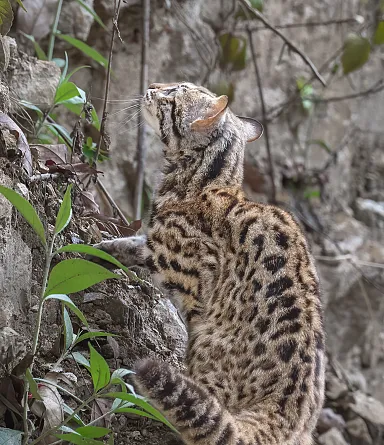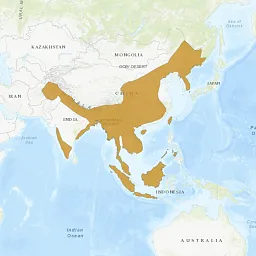
Leopard cat photo © Morten Ross · some rights reserved
Leopard Cat
Species Facts
The small, slim, spotted leopard cat varies so much in coloration and size that it was originally thought to be several different species.
- Scientific Designation: Prionailurus bengalensis
- Endangered Status: Least Concern (LC)
- Lifespan: Up to 15 years
- Weight: 3-7 kg
- Body Length: 44-107 cm
- Shoulder Height: 41 cm
- Tail Length: 15-44 cm
Profile
Although about the size of a domestic house cat, the leopard cat has longer legs, a relatively small head with a short, narrow muzzle, and moderately long, rounded ears. The background color of the coat is tawny or pale silvery grey and the underparts white, but the color and pattern of the markings vary widely. Black spots of varying size and shape cover the body and limbs, including the tail. The head is marked with two prominent dark stripes that extend from the inner corner of each eye to the base of the ear.
Diurnal in nature, leopard cats are also agile climbers and can be quite arboreal, hunting and resting comfortably at three to four meters off the ground. These cats feed on a variety of small prey, including mammals, lizards, amphibians, birds, and insects.

Species Distribution
This cat has the broadest geographic distribution of all the small Asian cats, inhabiting forest areas throughout Southeast Asia, spanning 21 countries including China. These cats inhabit habitats from lowland tropical evergreen rainforest and plantation forests at sea level to moist temperate and dry coniferous forests in the Himalayan foothills at elevations of 1,000 to 3,000 meters. This species also does well in farmland environments and on coastal islands.
Distribution map courtesy of IUCN (International Union for Conservation of Nature), compiled in 2015.

Perching Leopard Cat in Borneo.
Threats to the Leopard Cat
Although the leopard cat seems able to adapt and live near human settlements, this species is pressured by broadscale habitat modification and forest clearance for agriculture, tea plantations, and exotic tree plantations. This is largely because cleared areas lack the understory preferred by both the cat and its prey. This cat is also threatened by hunting for skins. Currently, the leopard cat is classified under the Least Concern (LC) category of the International Union for Conservation of Nature’s (IUCN) Red List and is protected under appendices I and II in the Convention on International Trade in Endangered Species (CITES).
Want to help us research and conserve this species?
Felidae Conservation Fund helps researchers around the world study and protect felids of all sizes.
Make sure you write a comment with "Leopard Cat" so we can designate 100% of your donation to go to protecting this species.
Do You Have 2-4 Hours A Month To Preserve Your Local Ecosystem?
Our volunteers are the driving force behind making true change in ecosystem health and wild cat conservation. Some like to volunteer in the field, others help us maintain our online presence, and some work with events. With just a few hours a month, you can make a difference, too.
Make A Difference Right Now
As a 501(c)3 nonprofit, our work is only possible because of generous donors like you.
More than 90% of your donation will go directly to our groundbreaking research, outreach, and education programs.
This is where true change starts. If you’d like to be a part of it, make a donation to Felidae Conservation Fund today:
Or,
